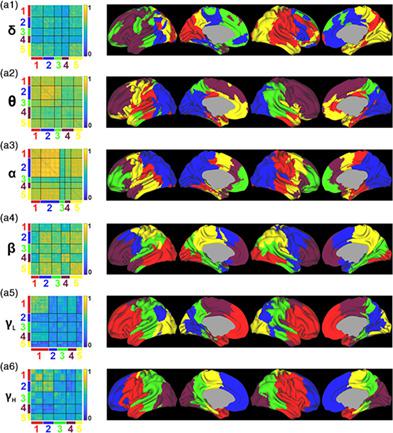当前位置:
X-MOL 学术
›
Hum. Brain Mapp.
›
论文详情
Our official English website, www.x-mol.net, welcomes your
feedback! (Note: you will need to create a separate account there.)
Investigating the spectral features of the brain meso-scale structure at rest
Human Brain Mapping ( IF 3.5 ) Pub Date : 2021-07-31 , DOI: 10.1002/hbm.25607 Riccardo Iandolo 1 , Marianna Semprini 1 , Diego Sona 2, 3 , Dante Mantini 4, 5 , Laura Avanzino 6, 7 , Michela Chiappalone 1
Human Brain Mapping ( IF 3.5 ) Pub Date : 2021-07-31 , DOI: 10.1002/hbm.25607 Riccardo Iandolo 1 , Marianna Semprini 1 , Diego Sona 2, 3 , Dante Mantini 4, 5 , Laura Avanzino 6, 7 , Michela Chiappalone 1
Affiliation

|
Recent studies provide novel insights into the meso-scale organization of the brain, highlighting the co-occurrence of different structures: classic assortative (modular), disassortative, and core-periphery. However, the spectral properties of the brain meso-scale remain mostly unexplored. To fill this knowledge gap, we investigated how the meso-scale structure is organized across the frequency domain. We analyzed the resting state activity of healthy participants with source-localized high-density electroencephalography signals. Then, we inferred the community structure using weighted stochastic block-model (WSBM) to capture the landscape of meso-scale structures across the frequency domain. We found that different meso-scale modalities co-exist and are diversely organized over the frequency spectrum. Specifically, we found a core-periphery structure dominance, but we also highlighted a selective increase of disassortativity in the low frequency bands (<8 Hz), and of assortativity in the high frequency band (30–50 Hz). We further described other features of the meso-scale organization by identifying those brain regions which, at the same time, (a) exhibited the highest degree of assortativity, disassortativity, and core-peripheriness (i.e., participation) and (b) were consistently assigned to the same community, irrespective from the granularity imposed by WSBM (i.e., granularity-invariance). In conclusion, we observed that the brain spontaneous activity shows frequency-specific meso-scale organization, which may support spatially distributed and local information processing.
中文翻译:

研究静止状态下大脑细观结构的光谱特征
最近的研究为大脑的中观组织提供了新的见解,强调了不同结构的共现:经典的选型(模块化)、不选型和核心-外围结构。然而,大脑细观尺度的光谱特性大多仍未被探索。为了填补这一知识空白,我们研究了如何在频域上组织细观尺度结构。我们使用源定位高密度脑电图信号分析了健康参与者的静息状态活动。然后,我们使用加权随机块模型(WSBM)推断群落结构,以捕获频域中的中尺度结构的景观。我们发现不同的中尺度模式共存,并且在频谱上以不同的方式组织。具体来说,我们发现了核心-外围结构的优势,但我们也强调了低频带(<8 Hz)中的不协调性和高频带(30-50 Hz)中的协调性的选择性增加。我们通过识别那些同时表现出最高程度的相配性、不相配性和核心-外围性(即参与)和(b)一致的大脑区域,进一步描述了中观尺度组织的其他特征。分配给同一个社区,无论 WSBM 施加的粒度如何(即粒度不变性)。总之,我们观察到大脑自发活动显示出频率特定的中尺度组织,这可能支持空间分布和局部信息处理。
更新日期:2021-09-19
中文翻译:

研究静止状态下大脑细观结构的光谱特征
最近的研究为大脑的中观组织提供了新的见解,强调了不同结构的共现:经典的选型(模块化)、不选型和核心-外围结构。然而,大脑细观尺度的光谱特性大多仍未被探索。为了填补这一知识空白,我们研究了如何在频域上组织细观尺度结构。我们使用源定位高密度脑电图信号分析了健康参与者的静息状态活动。然后,我们使用加权随机块模型(WSBM)推断群落结构,以捕获频域中的中尺度结构的景观。我们发现不同的中尺度模式共存,并且在频谱上以不同的方式组织。具体来说,我们发现了核心-外围结构的优势,但我们也强调了低频带(<8 Hz)中的不协调性和高频带(30-50 Hz)中的协调性的选择性增加。我们通过识别那些同时表现出最高程度的相配性、不相配性和核心-外围性(即参与)和(b)一致的大脑区域,进一步描述了中观尺度组织的其他特征。分配给同一个社区,无论 WSBM 施加的粒度如何(即粒度不变性)。总之,我们观察到大脑自发活动显示出频率特定的中尺度组织,这可能支持空间分布和局部信息处理。











































 京公网安备 11010802027423号
京公网安备 11010802027423号